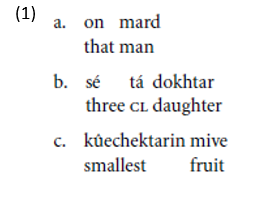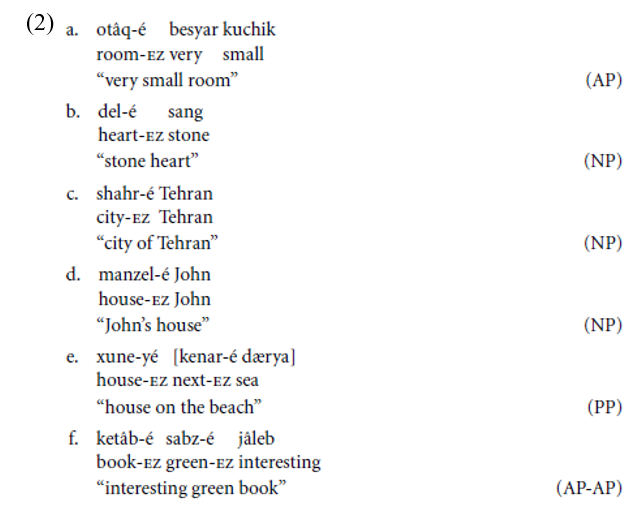


 Grammar
Grammar
 Tenses
Tenses
 Present
Present
 Past
Past
 Future
Future
 Parts Of Speech
Parts Of Speech
 Nouns
Nouns
 Verbs
Verbs
 Adverbs
Adverbs
 Adjectives
Adjectives
 Pronouns
Pronouns
 Pre Position
Pre Position
 Preposition by function
Preposition by function 
 Preposition by construction
Preposition by construction
 Conjunctions
Conjunctions
 Interjections
Interjections
 Grammar Rules
Grammar Rules
 Linguistics
Linguistics
 Semantics
Semantics
 Pragmatics
Pragmatics
 Reading Comprehension
Reading Comprehension| Farsi (Samiian 1994; Ghomeshi 1997; Ghozati 2000; Kahnemuyipour 2000) |
|
|
|
Read More
Date: 2024-01-19
Date: 1-3-2022
Date: 2025-04-02
|
Farsi (Samiian 1994; Ghomeshi 1997; Ghozati 2000; Kahnemuyipour 2000)
Farsi shows the basic Ezafe pattern in a simple form. The language contains prenominal demonstratives (1a) and numerals (1b); superlatives seem to be the only case of prenominal adjectives (1c).

Otherwise all modifying elements occur postnominally and typically require Ezafe, including APs (2a), descriptive NPs (2b, c), genitive NPs (2d), and some PPs (2e). The construction is recursive, insofar as multiple modifiers of these kinds trigger multiple occurrences of Ezafe (2f).

As noted earlier, relative clause modifiers, which are also postnominal, do not trigger Ezafe (3). They are introduced by a relative morpheme (î) that may be historically related to Ezafe, but is considered synchronically distinct by Persian grammarians.

|
|
|
|
تحذير من "عادة" خلال تنظيف اللسان.. خطيرة على القلب
|
|
|
|
|
|
|
دراسة علمية تحذر من علاقات حب "اصطناعية" ؟!
|
|
|
|
|
|
|
العتبة العباسية المقدسة تحذّر من خطورة الحرب الثقافية والأخلاقية التي تستهدف المجتمع الإسلاميّ
|
|
|